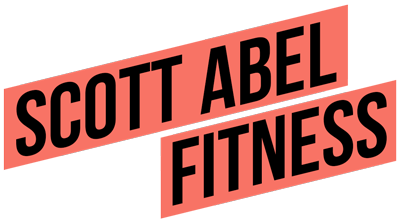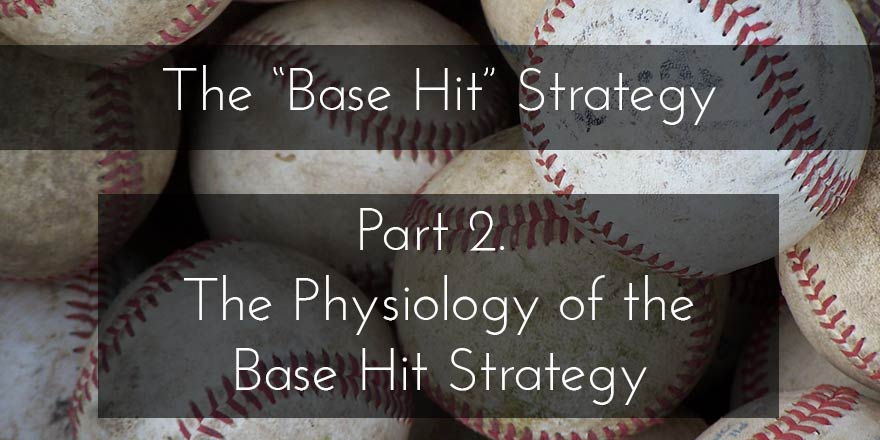In Part 1 of this base-hit strategy series, I explained a training strategy I employ with many of my clients. I explained it by comparing the mindset between a home-run effort and a base-hit effort when it comes to training intensity.
The fact is that life-stressors cannot be compartmentalized and separated from your training. Training intensity is a physical stress and this adds to mental and emotional stressors of living our day-to-day lives
…and the reverse is true as well.
We have only so much vitality and energy stored up for day-to-day use. Then it must be replenished. My “base hit” strategy is all about real people living in the real world, and it's about the fact that training intensity is not a mere one-dimensional idea that either intensity is there or it’s not.
So now in Part 2 I want to get a little deeper into the physiological concepts involved here, and why and how training consistency is more important at any given time than is training intensity.
Unless you earn your living as a pro athlete of some kind, you need to have “a healthy perspective” toward your training efforts. “All out to burn out” makes no sense!
Experts have defined the art of productive and progressive adaptive response to training as finding the optimal balance of two requisites that determine results: work and rest/stimulus and recovery, both general and specific. For every trainee — for every one of you that is –this balance is different and it depends on many different things as well. (See my book The Abel Approach for more.)
There’s training hard and then there’s training smart. Training smart includes the element of training hard, but within reason. However, training hard doesn’t always include training smart. As I said in Part 1, this nonsense of “Go Hard or Go Home” makes for a good t-shirt or bumper sticker, but it doesn't have much relevance in consideration of how to blend training hard with training smart for people living in the real world.
The fact is that average regular people who have very regular real-life stressors need to know that these daily life-stressors affect recovery as well.
The more stress you have in your life outside the gym, the more you should be applying the base-hit mindset strategy inside the gym!
You don’t have to go hard or go home every workout. More often than not, It’s ok, to just make sure you “go” …then go home.
It isn’t just the average regular trainee that this applies to either. The seasoned and experienced weight-training trainee in his or her physical prime, frequently handling maximum efforts is both doable and necessary for optimum progress of course. But the majority of you training with weights will be doing so for a purpose other than competition. Family, careers, travel, age, injury or chronic conditions, and quite frankly a lack of discipline and motivation will prevent most trainees from doing all that is necessary to prepare for a schedule that calls for a maximum efforts output at every training session. You simply can’t “get it up” to go all out 5-6 days per week, neither physically or psychologically, and nor should you.
For so many of you – especially for hardgainers – you have also likely noticed that the harder you push your body, the more stubbornly it refuses to change. Then at some point you just burn out on all that applied ‘home-run’ effort.
Furthermore, we know that the more advanced a trainee becomes, the greater the importance of understanding this stress/recovery/adaptation model and its approach to balancing these two elements of constructive human adaptation to training: 1) the workload must be sufficient to disrupt biological equilibrium enough to drive an adaptation, yet not be so excessive to the point of constituting an unmanageable level of stress, and 2) recovery must be sufficient to enable the adaptation to occur. This is why not all training should be “load-focused” It’s not always about “lifting heavier.” If you read my book The Abel Approach then you understand that important “internal cues” of biofeedback should supersede “external cues” like how much weight you lifted this week compared to last week, or whatever.
And in terms of applied intensity levels, things like age, gender, lifestyle stressors, injuries, and recent training history should always exert more influence over where to start programs, and how to execute a program, than does a loose or solid relationship to a previous way of doing things. As I talked about in Part 1, how you used to train years ago may now be something that holds you back or burns you out. I know for myself I could never go back to training like I did in my 20’s and 30’s. It would be silly of me to think I could.
Maybe, like me, back in your younger years of working out you trained every day and sometimes you stayed up all night and still trained the next day; and you did forced reps and extended sets and you slept all day if you wanted to. That likely isn’t your reality anymore.
Maybe you were a young female figure competitor working as a personal trainer with not a lot of stress in your life. But now you are a busy mother with a hectic schedule and kids to take care. You can’t apply your training intensity the same way anymore, and nor should you. This is when the flexibility of the base-hit strategy comes in.
Sure, you can still do tough programs. You can still apply yourself. But some days you may just have to back off intensity in terms of training pace, training load, or overall volume. This is what the base-hit mindset strategy is all about. It’s about respecting your stress levels and acting accordingly when going in to do your workout. The important thing is to be able to be consistent – not to flash and burn out because of not listening to your body – and trying to hit a home-run in every training session. Now – let’s talk about intensity and stress and the cortisol connection as well
The Cortisol Consideration
Consider that cortisol is a normal stress hormone in the body. A little is normal, but a lot is a red flag that you are ignoring your stress levels. Cortisol is secreted in response to both the physical stress of a hard workout, and the psychological stress of the many factors that play upon our psyches, such as personal relationship problems, sleep deprivation and insomnia, psychological issues related to disease processes or illness, the loss of a loved one, or simple disruptions in lifestyle like job loss, schedule change, or even a vacation. Even daily schedules of “busyness” can be a source of stress that must be paid attention to. Too many people don’t pay attention to the cumulative effects of daily stress and they do so to their own detriment.
Normal cortisol secretion promotes protein degradation and the conversion of proteins into carbohydrates, and conserves glucose by promoting fat utilization. But at higher levels cortisol promotes hyperglycemia, depresses immune function, intensifies perceptions of fatigue, and is also likely one of the mechanisms that produces the symptoms of clinical depression often associated with severe overtraining. (I’ll discuss that in an upcoming article on overtraining.)
Since exercise-induced cortisol levels are elevated transiently, a chronic elevation in cortisol could be the result of the effects of overlapping workouts that may not allow sufficient time for levels to drop back to baseline.
This, coupled with the adverse psychological factors associated with overtraining or training too hard and too often, and with the worry and stress associated with other real-life events and circumstances… well then chronically elevated cortisol levels are more than likely, and they will become a major potential contributor to overtraining or burnout.
You can’t just go to the gym for every workout seeking a “home run” if you have many other life-stressors already heavily influencing and impacting your day. These mental and emotional life-stressors impact you physiologically as well in the form of stress hormone response and in particular cortisol (and aldosterone).
Every trainee responds differently to stress to some degree, and age, gender, and recovery status will produce wide variations in these hormonal responses. Essentially, a good coach must make an educated guess as to how to tailor the training program to induce the necessary hormonal changes required to drive improved performance. That has to do with the art and nuance of program design.
But YOU as a trainee, you need to know when you can go to your workout with a mindset of home-run intensity vs. being smart and mature and following through your workout for consistency’s sake, but with more of a “base-hit strategy.” It is better to leave the gym thinking you could have done more, than to leave the gym with no energy for anything else.
The late strength expert Charlie Francis was on to something. He said “it is always better to undertrain than to overtrain. You will still produce adaptive stress, but maybe not to the same degree.” Once you overtrain, your body’s resilience will plummet and fight to retain a balance. Smaller CNS demands over a longer period of time result in more acceptance and greater improvement, while the rush to get more done “right now” because of excitement and enthusiasm leads to consequences down the road like burnout. This latter consequence is the equivalent of swinging for that home run in terms of applied intensity, only to find out that in real terms, you just struck out.
The take home message here is that you can still make gains and progress when you undertrain, but when you reach overtraining, you lose everything. A base-hit mindset strategy keeps the inning alive and keeps you training consistently. But a series of strikeouts from swinging for the fences with every workout – does not.
The closer you are to your individual physical potential, the more important the cumulative effects of a series of workouts become. The less important any one single “standout” workout session becomes. Consistency always trumps intensity. So you can keep up with some personal trainer pounding you into the ground today. Well that is today. And that may well zap you from performing tomorrow or next week. It’s time to consider that the cumulative effects of applied training are more important than the immediate effects of one hard training session. It’s ok to back off training intensity today so that you can still be training tomorrow.
This may not sound “hardcore.” But “hardcore” also refers to lifestyle. As I said in Part 1, real people with real lives need to consider variations and flexibility in terms of applying intensity. It isn’t “pansy” or “pussy” to back off when your body is telling you it’s just not there today. To do so, is the mature intelligent approach to training. And it will keep you from burning out from the over-application of the “home-run” mindset to your workout. It’s important not to just have your body and your heart in your workout, but your head as well! I will continue this in Part 3.
Some of you will get it. Some of you will not.

